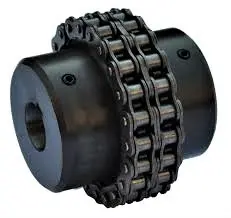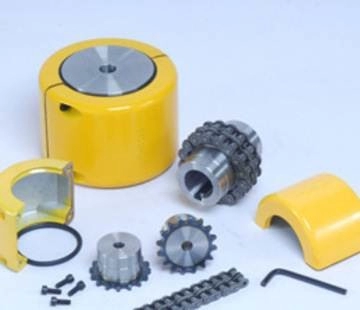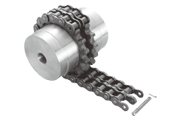Product Description
Product Description
Roller chain couplings have the advantages of simple structure, convenient loading and unloading, large torque transmission, and easy operation. However, there is significant wear between the chains, especially during high-speed operation when the radial motion generated by centrifugal force will accelerate their wear. Therefore, it is not suitable for use at high speeds and under impact loads, nor for the connection of vertical shafts.
When designing the overall structure of the coupling, full attention should be paid to the lubrication and dust prevention between the tooth surface and the rollers, and an outer shell should be added. In addition to dust and oil storage, it also has a protective effect. Because if the chain breaks, it may cause personal accidents.
The double row sleeve roller chain coupling has formed a standard (old standard GB6069-85, new standard GB/T 6069-2002). The transmission torque and allowable speed are 4 times and 2 times that of a single row roller chain of the same size, respectively. Because when the chain size is determined, it can accommodate 2 teeth within the width of a single row of sleeve rollers, while a double row can only accommodate 1 tooth, the tooth thickness of a single row is only half of that of a double row. So, the rollers of the double row chain are located in the grooves of the main and driven sprockets, and when subjected to force, they rotate independently without interfering with each other, reducing wear.
Product Parameters
| model | Nominal torqueTnN·m | Allowable speed(n) r/min |
Axis hole diameter d1,d2 |
Axis hole length | Chain number | chain Pitch |
Number of teeth Z |
D | b1 | S | A | Dx () |
Lx () |
kg | Transmission inertiakg·m2 | ||
| Ymodel | J1model | ||||||||||||||||
| No cover installed | Installing cover | L | L1 | ||||||||||||||
| GL1 | 40 | 1400 | 4500 | 16 | 42 | – | 06B | 9.525 | 14 | 51.06 | 5.3 | 4.9 | – | 70 | 70 | 0.40 | 0.0571 |
| 18 | 42 | – | – | ||||||||||||||
| 19 | 42 | – | – | ||||||||||||||
| 20 | 52 | 38 | 4 | ||||||||||||||
| GL2 | 63 | 1250 | 4500 | 19 | 42 | – | 06B | 9.525 | 16 | 57.08 | 5.3 | 4.9 | – | 75 | 75 | 0.70 | 0.0571 |
| 20 | 52 | 38 | 4 | ||||||||||||||
| 22 | 52 | 38 | 4 | ||||||||||||||
| 24 | 52 | 38 | 4 | ||||||||||||||
| GL3 | 100 | 1000 | 4000 | 20 | 52 | 38 | 08B | 12.7 | 14 | 68.88 | 7.2 | 6.7 | 12 | 85 | 80 | 1.1 | 0.00038 |
| 22 | 52 | 38 | 12 | ||||||||||||||
| 24 | 52 | 44 | 12 | ||||||||||||||
| 25 | 62 | – | 6 | ||||||||||||||
| GL4 | 160 | 1000 | 4000 | 24 | 52 | – | 08B | 12.7 | 16 | 76.91 | 7.2 | 6.7 | – | 95 | 88 | 1.8 | 0.0 |
| 25 | 62 | 44 | 6 | ||||||||||||||
| 28 | 62 | 44 | 6 | ||||||||||||||
| 30 | 82 | 60 | – | ||||||||||||||
| 32 | 82 | 60 | – | ||||||||||||||
| GL5 | 250 | 800 | 3150 | 28 | 62 | – | 10A | 15.875 | 16 | 94.46 | 8.9 | 9.2 | – | 112 | 100 | 3.2 | 0.0571 |
| 30 | 82 | 60 | – | ||||||||||||||
| 32 | 82 | 60 | – | ||||||||||||||
| 35 | 82 | 60 | – | ||||||||||||||
| 38 | 82 | 60 | – | ||||||||||||||
| 40 | 112 | 84 | – | ||||||||||||||
| GL6 | 400 | 630 | 2500 | 32 | 82 | 60 | 10A | 15.875 | 20 | 116.57 | 8.9 | 9.2 | – | 140 | 105 | 5.0 | 0.0058 |
| 35 | 82 | 60 | – | ||||||||||||||
| 38 | 82 | 60 | – | ||||||||||||||
| 40 | 112 | 84 | – | ||||||||||||||
| 42 | 112 | 84 | – | ||||||||||||||
| 45 | 112 | 84 | – | ||||||||||||||
| 18 | 112 | 84 | – | ||||||||||||||
| 50 | 112 | 84 | – | ||||||||||||||
| GL7 | 630 | 630 | 2500 | 40 | 112 | 60 | 12A | 19.05 | 18 | 127.78 | 11.9 | 10.9 | – | 150 | 122 | 7.4 | 0.012 |
| 42 | 112 | 60 | – | ||||||||||||||
| 45 | 112 | 60 | – | ||||||||||||||
| 48 | 112 | 84 | – | ||||||||||||||
| 50 | 112 | 84 | – | ||||||||||||||
| 55 | 112 | 84 | – | ||||||||||||||
| 60 | 142 | 107 | – | ||||||||||||||
| GL8 | 1000 | 500 | 2240 | 45 | 112 | 84 | 16A | 25.40 | 16 | 154.33 | 15.0 | 14.3 | 12 | 180 | 135 | 11.1 | 0.571 |
| 48 | 112 | 84 | 12 | ||||||||||||||
| 50 | 112 | 84 | 12 | ||||||||||||||
| 55 | 112 | 84 | 12 | ||||||||||||||
| 60 | 142 | 107 | – | ||||||||||||||
| 65 | 142 | 107 | – | ||||||||||||||
| 70 | 142 | 107 | – | ||||||||||||||
| GL9 | 1600 | 400 | 2000 | 50 | 112 | 84 | 16A | 25.4 | 20 | 186.50 | 15.0 | 14.3 | 12 | 215 | 145 | 20.0 | 0.061 |
| 55 | 112 | 84 | 12 | ||||||||||||||
Packaging & Shipping
After Sales Service
If during transportation or if the customer receives the goods, opens the packaging and finds any damage, they can resend a new product to the customer.
/* January 22, 2571 19:08:37 */!function(){function s(e,r){var a,o={};try{e&&e.split(“,”).forEach(function(e,t){e&&(a=e.match(/(.*?):(.*)$/))&&1

Real-World Examples of Successful Roller Chain Coupling Installations and Benefits
1. Industrial Conveyor Systems:
Roller chain couplings are widely used in industrial conveyor systems to transmit power between the driving and driven shafts. They provide reliable torque transmission and can accommodate misalignments, ensuring smooth and efficient operation of the conveyor. The benefits include reduced downtime due to their robustness and the ability to handle heavy loads in demanding environments.
2. Heavy Machinery Applications:
In heavy machinery such as mining equipment, steel mills, and large cranes, roller chain couplings play a crucial role in transmitting power from the motor to various mechanical components. The ability to withstand high torque and shock loads ensures the safe and efficient operation of these machines. Roller chain couplings’ durability reduces maintenance requirements and enhances overall system reliability.
3. Pumping Systems:
Roller chain couplings are used in pumping systems for various industries, including water treatment, oil and gas, and chemical processing. They offer the advantage of absorbing vibration and shock loads, contributing to the smooth and continuous operation of pumps. Their flexibility allows them to compensate for any misalignment between the motor and pump shafts, reducing stress on the equipment and increasing its lifespan.
4. Paper and Pulp Industry:
In the paper and pulp industry, roller chain couplings are employed in various applications, including paper machines and pulp processing equipment. Their ability to handle high-speed and high-torque requirements makes them suitable for demanding tasks. Roller chain couplings contribute to reduced maintenance costs and improved productivity by ensuring efficient power transmission in critical processes.
5. Automotive Manufacturing:
Automotive manufacturing plants use roller chain couplings in assembly line machinery and robotic systems. The couplings help in providing precise power transmission, ensuring accurate and synchronized movement of equipment. This results in improved production efficiency and reduced downtime, leading to cost savings and enhanced manufacturing output.
Overall, roller chain couplings have demonstrated their effectiveness and versatility across various industries. Their ability to handle misalignments, shock loads, and high torque makes them an excellent choice for demanding applications where reliability and efficiency are critical.
“`
Roller Chain Couplings in Applications Requiring Frequent Starts and Stops
Yes, roller chain couplings can be used in applications that require frequent starts and stops. These couplings are designed to provide reliable torque transmission and accommodate misalignments even during repetitive and rapid motion changes.
The key features that make roller chain couplings suitable for such applications include:
- Durable Construction: Roller chain couplings are typically constructed from high-quality materials, such as steel or stainless steel, which offer excellent durability and resistance to wear and fatigue.
- Shock Absorption: The flexible nature of roller chain couplings allows them to absorb shocks and vibrations that may occur during frequent starts and stops, preventing damage to connected equipment.
- Backlash Minimization: Roller chain couplings are designed to minimize backlash, which is the amount of free play between the connected shafts. This feature ensures precise and reliable torque transmission, even when starting and stopping repeatedly.
- Smooth Operation: The chain and sprocket design of roller chain couplings allows for smooth operation, reducing jarring movements during starts and stops.
- Misalignment Tolerance: Roller chain couplings can accommodate angular and parallel misalignments between shafts, which is essential in applications where frequent starts and stops may lead to slight shifts in the alignment.
- Easy Maintenance: Roller chain couplings are relatively easy to maintain, making them suitable for applications requiring frequent operation. Regular inspection and lubrication can help ensure optimal performance.
It is important to select the appropriate size and type of roller chain coupling based on the specific requirements of the application, including the expected frequency of starts and stops. Proper maintenance and monitoring of the coupling’s condition can help prolong its lifespan and ensure smooth operation even in demanding applications with frequent motion changes.

Working Principle of Roller Chain Coupling and Its Advantages
A roller chain coupling works on the principle of transferring torque between two shafts using a roller chain wrapped around sprockets on each shaft. The sprockets are connected by the roller chain, and when one sprocket rotates, it drives the other sprocket, transmitting the torque from one shaft to the other.
The advantages of roller chain couplings over other coupling types include:
- High Torque Capacity: Roller chain couplings can handle high torque loads, making them suitable for heavy-duty industrial applications.
- Compact Design: The compact and simple design of roller chain couplings allows for easy installation in tight spaces and restricted environments.
- Misalignment Tolerance: Roller chain couplings can accommodate angular, parallel, and axial misalignments between the shafts, reducing the need for precise alignment during installation.
- Shock Absorption: The inherent flexibility of the roller chain allows it to absorb shocks and dampen vibrations, protecting connected equipment from sudden loads and impacts.
- Cost-Effective: Roller chain couplings are generally cost-effective compared to other coupling types, providing an economical solution for power transmission needs.
- Wide Application Range: Roller chain couplings are used in various industries, including manufacturing, agriculture, construction, and material handling, due to their versatility and reliable performance.
- Easy Maintenance: Roller chain couplings are relatively easy to maintain and require minimal lubrication to keep the chain running smoothly.
- Long Service Life: When properly installed and maintained, roller chain couplings offer a long service life, contributing to the overall efficiency and reliability of mechanical systems.
Overall, the working principle and advantages of roller chain couplings make them a popular choice for transmitting torque between shafts in diverse industrial applications.


editor by CX 2024-04-30